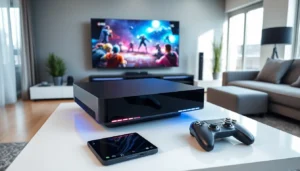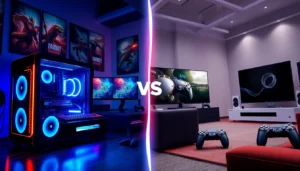Table of Contents
ToggleImagine a world where your gaming adventures can follow you anywhere, where you don’t need to lug around bulky hardware or wait for updates longer than your last boss battle. Enter the cloud gaming console, the hero we never knew we needed. This cutting-edge technology might just turn your gaming dreams into reality, while keeping your couch potato lifestyle intact. Ready to explore? Let’s immerse.
What Is a Cloud Gaming Console?

A cloud gaming console is a revolutionary device that allows gamers to play video games over the internet instead of relying on traditional hardware. Picture this: rather than needing a high-performance gaming rig or the latest console, users can stream games directly to their device, whether it’s a smart TV, tablet, laptop, or smartphone.
This model shifts the heavy lifting from the console to the cloud servers, making it a breeze for players to access a vast library of games anytime they like. Just think of it as Netflix, but for video games.
In essence, cloud gaming consoles simplify the gaming experience. Less time spent on installations or downloads means more time for action-packed gameplay. They also offer flexibility, players can switch between devices seamlessly, letting them game at home on a big screen or on-the-go with a smartphone. No need for expensive hardware upgrades, either.
How Cloud Gaming Consoles Work
So, how exactly do cloud gaming consoles work? It all boils down to a few technological marvels working together to provide a stress-free gaming experience. At their core, they rely on high-speed internet connectivity and powerful remote servers.
Here’s the deal:
- Data Processing: When you hit the ‘play’ button, your commands are sent to a remote server, often located miles away. The heavy processing of graphics and game mechanics occurs here, not on your local system.
- Streaming: Once the server processes your commands, it sends the visual and audio data back to your device via the internet. This streaming process is akin to watching a video but with the added twist of your input affecting what’s happening on-screen in real-time.
- Latency Management: Naturally, delays can be a gamer’s worst nightmare. Cloud gaming services continuously strive to minimize latency, the lag between your actions and the game’s response. They use advanced algorithms and dedicated routing to ensure a seamless process.
Finally, users typically subscribe to these services, which grant them access to a wide array of games without the need for individual purchases.
Benefits of Cloud Gaming Consoles
Cloud gaming consoles come with a smorgasbord of benefits that are hard to ignore. Here are a few features that make them truly special:
- Cost-Effectiveness: Forget about shelling out big bucks for the latest hardware. With cloud gaming, the need for expensive consoles or gaming PCs diminishes significantly. Users pay a subscription fee instead, which is often cheaper than buying multiple games and systems.
- Instant Access: Nope, no more waiting around for downloads or installations. Gamers can dive straight into their chosen games within moments. It’s a welcome change for anyone tired of staring at loading screens.
- Convenience: Whether it’s on a couch or a long commute, players can game wherever there’s an internet connection. This flexibility adds a huge appeal, especially for those who want to game without being tethered to a console.
- Diverse Game Library: Most cloud gaming services boast extensive libraries filled with games from various genres. Players can explore new titles without committing to purchasing them outright.
In short, cloud gaming consoles present significant advantages that cater to modern gamers’ diverse lifestyles.
Popular Cloud Gaming Consoles on the Market
Several cloud gaming consoles have made waves in the market, offering exciting options for both casual and hardcore gamers alike. Here’s a quick look at a few notable ones:
- NVIDIA GeForce NOW: Known for its powerful streaming capabilities, GeForce NOW allows users to play games they already own on various platforms. It operates on a freemium model, providing both free access and premium subscriptions for enhanced performance.
- Google Stadia: Though it’s faced ups and downs, Stadia aimed to deliver an innovative gaming experience by letting players stream games without a console. It offers a mix of free and paid titles.
- Xbox Cloud Gaming (formerly xCloud): Part of the extensive Xbox Game Pass service, this option lets players tap into a vast library of Xbox games, playable on many devices, thanks to cloud technology.
- PlayStation Now: Sony’s answer to cloud gaming, PlayStation Now, offers a vast selection of PS2, PS3, and PS4 titles for streaming or download.
Each platform has its strengths, allowing users to find the best fit for their gaming needs.
Challenges and Limitations of Cloud Gaming Consoles
But, cloud gaming consoles aren’t without their hurdles. While they’re gaining traction, several challenges remain:
- Internet Dependence: A reliable high-speed internet connection is a must. Without it, gameplay can suffer from latency and buffering, ruining the experience.
- Data Caps: Many internet service providers impose data caps or throttling. This can limit long gaming sessions or result in additional charges for high usage. Gamers need to watch their data consumption, especially when streaming high-quality graphics.
- Limited Game Availability: Not every game is available on cloud platforms, this can hinder gamers’ choices and innovation in the gaming landscape.
- Performance Variability: The quality of cloud gaming can fluctuate based on server traffic and other factors. Some gamers may witness lag or decreased performance, impacting competitiveness.
Addressing these challenges will be essential for cloud gaming’s future success.
The Future of Cloud Gaming Consoles
What’s in store for cloud gaming consoles? The future looks bright. With technological advancements, several trends may emerge:
- Improved Latency and Graphics: As internet speeds continue to increase, cloud gaming will likely offer even more responsive gaming experiences along with enhanced visuals delighted by newer compression algorithms.
- Wider Game Libraries: As more developers join the cloud gaming wave, players can expect a diverse range of titles, allowing them to indulge in their gaming fancies. This expansion may also spur innovation in the types of games created, specifically designed for cloud platforms.
- Better Subscription Models: Companies might explore flexible subscription options to cater to various audiences. Gamers may find packages that best suit their playing habits and preferences.
- Cross-Platform Play: Enhanced collaboration between developers may lead to games that can be played across different cloud platforms, further fostering community and engagement.
As the technology evolves, gamers will reap incredible benefits, making their gaming experiences seamless and more enjoyable.




